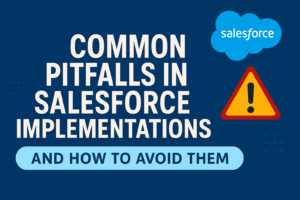BLOG
4 Ways to Increase Sales Through Social Media Marketing
Up to maybe 2 or 3 years ago, to the untrained eye, social media was a useless tool when it came to increasing sales. You can’t directly sell on social media plus the sites, and likes and retweets do not always equal sales growth.
If you are just getting into the swing of becoming a social media influencer and driving traffic to your site, then your social media content strategy will have to be aligned with your online presence and products. So then, the question is:
Does social media marketing increase sales? The answer is a thousand times YES.
Promote your brand, generate leads and build a presence on Social Media
We said that Facebook, Instagram and Pinterest lead to sales growth and lead generation.
On those platforms, your audience awaits you, and if you’re too slow to create accounts, your competitors will get to them before you. Social media is one of the best tools out there to simultaneously promote your brand, generate strong leads and, most importantly, grow your sales.
To make these platforms work for you, start by creating accounts and building a presence. Follow these four effective social media ideas to increase sales and maximize the effect of your content marketing strategy.
1. Research, post, repeat, track results
Especially when you’re trying to generate sales and leads. This first step takes a lot of work, but as you go, you’ll truly learn who your audience is and how you should go about reaching them.
After opening your accounts, begin by regularly posting.
Some marketers believe you shouldn’t post every day as it’s “too much,” but it’s not really too much until your audience says so. Post articles, ask questions to your audience. Invite them to share your page and visit your site.
Connect your social media accounts so your posts reach consumers on multiple platforms. Remember, not everyone has a Facebook and Twitter account.
Consider that Instagram and Pinterest have grown exponentially in the last few years. More so when it comes to marketing and lead generation, so you want to be sure you’re reaching out to them as well.

Using Google Analytics. Image source: Google Analytics Blog.
The key here is to post at various times of day to see which times get you the most interaction. At what times throughout the day did you get the most likes, retweets or other social media nods?
This will tell you two things:
- Your customers are online at this time. If you continue to post at or around this time, you have a better chance of reaching your audience.
- You’re posting the right kind of content that people are responding to. Keep at it and find new ways to get people commenting on your posts.
From here, you can be better assured that you’re reaching your target audience. But, even better, you’re giving them good information so people will return again and again.
Always keep looking for new ways to improve. Periodically, you should be posting at other times of the day to see if there is a demographic you are missing.
This first step is also easier if you have an analytics tool like Google Analytics. With this one tool, you’ll be able to monitor all sorts of activity on your website and your social media accounts. You’ll see how long the average person is staying on your website and how high or low your bounce rate is.
From here, you’ll be better able to see where improvements and adjustments can be made, just like Nissan Motor Company does. The car manufacturer uses Google Analytics to better understand their users’ preferences, such as colour, make and model, while still measuring conversion rates. Google Analytics was able to provide both features and help Nissan better tailor its ads and campaigns.
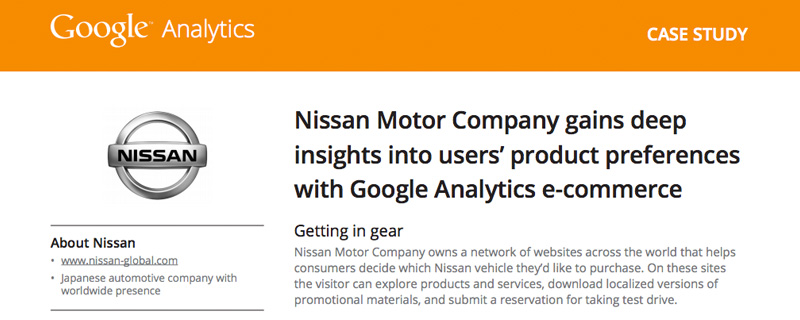
Google Analytics case study of Nissan Motor Company.
2. Branch outside traditional social media platforms
Every social media marketer worth his or her salt knows that having Facebook and Twitter accounts are essential. They have the biggest number of members, and those members are as diverse as any. From teenagers to their grandmas, you can find them on either Facebook or Twitter. Most marketers will also recommend their clients create other accounts with Pinterest, Instagram and YouTube to attract a more dedicated audience.
But did you know that social media really reaches beyond these platforms? Did you ever consider blogging, podcasts or live chats? These forms of social media are often overlooked because your audience isn’t immediately present.
Youtube Channels and Podcast have been booming for the last 2 years as they also give users a very personal experience. With a friendly way to bring in sponsors, podcasts have become great lead generators.

Why not try podcasting?
Blogging
Blogging is one of the best ways to establish a lasting relationship and conversation with potential clients. It’s a great way to keep clients coming back to your site over and over as you post more content.
Google’s algorithm also pushes websites that are frequently updated higher in their search results so you’ll have an added search engine optimisation advantage over your competitors.
Podcast
Similar to blogs, podcasts bring relevant content to your audience on a weekly or monthly basis, or really as often as you like. Many consumers like to see who they’re buying from, and if people can connect your face to your brand, they’ll be more likely to remember you. Podcasts also offer you the chance to host interviews with other industry experts as well as panel discussions about big news in your industry.
What’s better, podcast audiences trust the host’s recommendations, who are usually Top Media Influencers.
Live Chats and Forums
Live chats allow you to respond to consumers and connect with them. Platforms, such as Reddit’s “Ask Me Anything” threads and Google Plus’s hangouts, bring interested consumers to the table to get real, honest answers to their questions. This is a great opportunity for you to show off your personality and illustrate what makes your company stand out from your competitors.
An example of a company that uses blogging for increasing sales is Marriott International, the hotel chain that excels at business blogging.
CEO and writer Bill Marriott maintains an authentic voice and honest rendering of his life and his experiences throughout each article. Written from his perspective, the blog tackles Marriott’s personal adventures as well as his views on the hotel industry, offering personal advice for business success.
Who better to take advice from than one of the biggest hotel owners in the world?
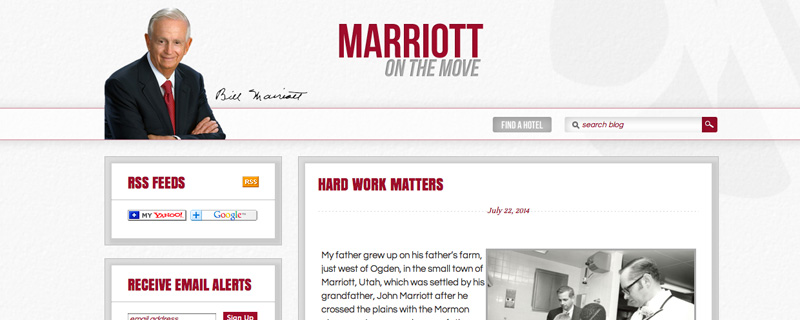
Bill Marriott’s blog gives a personal touch.
This is by far the best use of these mediums: establish yourself as an expert within your community. By writing creative content that offers helpful information to readers, you present yourself as more than just a seller. You’re someone who is active in his or her industry, someone who’s always looking out for the next advancement or the latest news. Your audience will come to see you as someone they can trust for honest advice and an answer to their industry questions.
When it comes time to buy, you’ll be the one they go to.
3. Make ’em work for it vs Freebies and Upselling
Heath Ledger’s Joker from 2008’s The Dark Knight is probably the last person you’d want to take business advice from, but he did have a point when he said, “If you’re good at something, never do it for free.”
A good social media marketer can take this and apply it to the content you’ve just created. You worked hard on it, and it’s generating quite the buzz around Facebook and other social media sites. More people are sharing it, and traffic is coming in more steadily to your site. Now, how do you turn avid readers into avid clients?
Let’s look at this from a different angle. Creating free content that will provide value to your audience and make them curious about what else you have to offer is nowadays a great strategy. This is your Lead Magnet, which should be followed by an entry, accessible product. Finally, you drive your customers through your sales funnel and start offering your “gold ticket” products or services.
By asking your reader or viewer to fill out a form or download your freebies, you ensure that you have a consumer who is genuinely interested –or intrigued at least– in you and your product or service.
Your audience wants the latest updates from your industry, and they know that a quality product or service is worth a few seconds of paperwork.
In turn, you’ll be able to pass on your lead to a salesperson or better direct your marketing efforts towards assisting your consumers’ most common problems. You’ll also see how people are finding you and get ideas on how people can better find out about you.
E-Commerce Sites to Increase Sales
For e-commerce sites, it’s almost essential for buyers to have their own accounts. They can put their favourite items on wish lists or in their shopping cart, which then allow you to see which products are selling the best and how you can better promote those products.
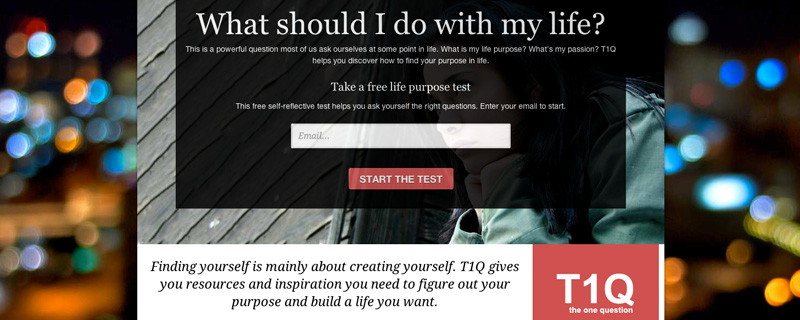
The One Question uses a different approach to get leads.
Your lead generation tactics don’t always have to be forms or accounts.
Get creative like the people at The One Question (T1Q). Their homepage asks, “What should I do with my life?” Viewers are then invited to take a short quiz to help them discover an answer, which requires giving T1Q an email address. Boom! A lead is generated, and now the user can work towards answering that question with the great content on T1Q’s site.
Now admittedly, some will turn back, but those who don’t are going to be stronger leads. Your form doesn’t have to be elaborate. In order to get an account, a customer should only need their name, a valid email address and maybe their birthday. Either feature should only take about 30 seconds to fill out, long enough to get some good information and short enough not to lose their attention.
4. Show up for your audience!
It isn’t always about posting questions on Facebook or blogging. Increasing sales through social media can come from directly responding to people who either are talking to you or about you.
Traditionally, businesses have remained stoic, announcing new information through press releases, but as per the latest trends in social media marketing the custom of interacting with customers has definitely come to stay.
Interact with your clients
Start by interacting with your clients through comments and tweeting back to them. You’ll show them that you value their input and opinion without coming on too strong. Be yourself and answer in the same voice that writes for your blogs and articles.
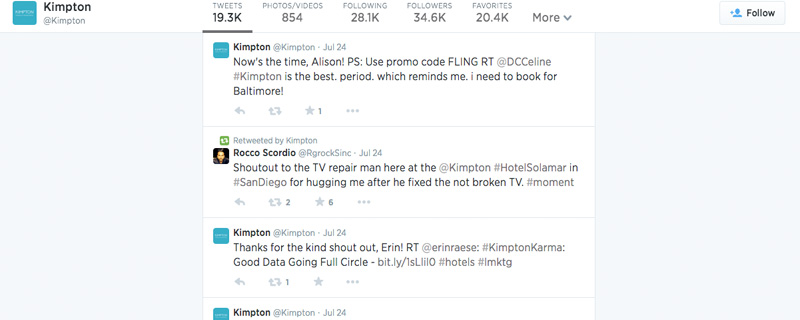
A company’s social media account can serve as a customer service extension.
You should also be posing questions regularly to garner feedback on how you’re perceived and what your company could do better. Customers love it when their voices are heard and taken seriously, and if you don’t open your mouth, how will you ever know?
No one really likes getting negative comments or complaints, but they can provide you with an opportunity to show clients that you take responsibility for your company and you’re willing to go the extra mile to please them.
If you handle a tense situation with open communication and a genuine desire to make things better, your customers will be more likely to look past the negative comment, respect you for facing the problem head-on and continue to buy from you.
Commenting on blogs and articles
Don’t forget about comment sections on blogs and articles. This is where your industry goes to discuss the subject and further debate or ask questions. Who better to answer those questions than a real expert? By answering these questions and providing links to your site, readers will start coming to you for more advice.
This tactic is especially effective if you’re on your competitor’s website. Don’t badmouth their company, but show that you are equally as competent and also have great ideas to share.
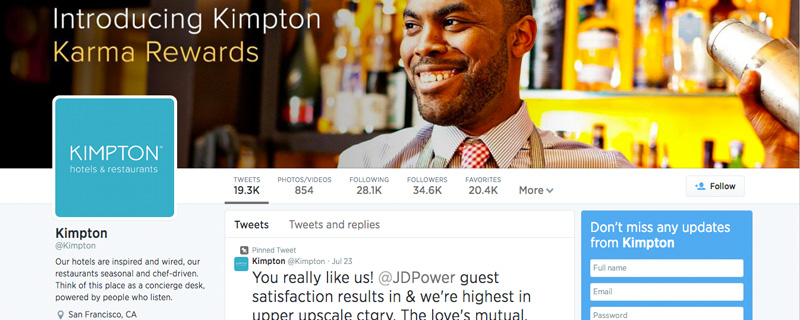
Kimpton Hotels and Restaurant use Twitter as a social listening desk.
One of the best examples of this is Kimpton Hotels and Restaurants, a master of using Twitter to its full advantage. The company hired four people to monitor what they call the social listening desk, a position all about watching what people were posting about the company and responding back in creative and memorable ways.
When one guest complimented the hotel but mentioned she was feeling unwell all in a tweet, the front desk sent her tea, soup and a kind get-well-soon card. The desk is also monitoring guests’ birthdays and other special occasions so they can make them extra special.
You might not have the manpower to routinely monitor every tweet or post to your Facebook page.
But the main takeaway point here is that by showing them that you care and you’ll go out on a limb for them, you’re giving them a lasting reminder that when they go to book a trip or order a dress, they’re going to go to you first.
Now, we want to hear from you! Are you using the power of social media to increase your sales? What do you struggle the most? Building a presence on Facebook? Let us know in the comments below.


